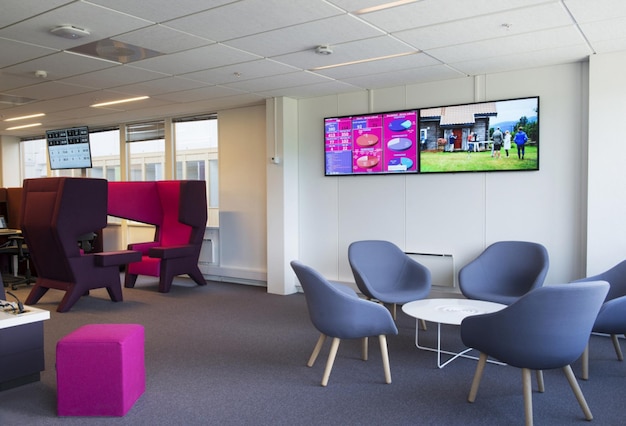Words can only go so far. Misunderstandings missed cues, and wasted time—these are the everyday struggles of teams relying too much on verbal and written communication. When instructions get buried in emails or meetings drag on with little impact, productivity takes a hit.
Now, here’s the real issue: employees process visuals 60,000 times faster than text. Yet, many workplaces still rely on outdated methods to share critical updates, performance metrics, and company goals. If your team isn’t on the same page, deadlines slip, mistakes pile up, and engagement drops.
That’s where visual communication comes in. It’s not about posters or whiteboards anymore. Digital signage is the game-changer. It keeps employees informed, aligned, and engaged—without pulling them into another unnecessary meeting.
To make digital signage work for your workplace, you need a structured plan. This guide breaks down:
- Why Visual Communication Improves Workplace Efficiency
- The must-have digital signage tools for better engagement
- The Step by step process
Case studies show that companies using digital signage see a 25% boost in employee engagement and fewer miscommunications—resulting in better decision-making and stronger team alignment. Let’s get into it.
How Visual Communication Fixes Workplace Bottlenecks and Speeds Up Productivity
Cluttered inboxes. Endless meetings. Confusing instructions. These slow teams down more than anything else. Workplace efficiency depends on how quickly and clearly information gets across—and traditional communication methods often fall short.
Text-heavy emails get skimmed and ignored. Verbal instructions get misinterpreted. Important updates get lost in the shuffle. The result? Delays, mistakes, and frustration.
How Visual Communication Changes the Game?
Switching to visual-first messaging eliminates the back-and-forth that slows teams down. Here’s how it makes a measurable difference:
- Faster Information Processing – Studies show that people understand visuals faster than text alone. A well-placed dashboard or real-time display ensures updates stick without overloading employees with unnecessary details.
- Better Retention – Employees retain 65% of visual information three days later, compared to just 10% of text-based content. This means fewer follow-ups, clearer expectations, and smoother workflows.
- Increased Engagement – Interactive and dynamic content grabs attention better than static emails or bulletins. Whether it’s KPI dashboards, company-wide alerts, or workflow updates, visual content makes key messages impossible to ignore.
- Stronger Team Alignment – When everyone sees the same data at the same time, decision-making speeds up. Employees stay informed, reducing the need for redundant meetings or unnecessary clarification requests.
Companies that prioritize visual communication see faster response times, fewer miscommunications, and increased productivity.
Essential Digital Signage Tools That Keep Employees Engaged
A well-placed digital screen can either drive engagement or blend into the background—it all depends on the tools behind it. The right digital signage setup ensures employees see, process, and act on important updates without friction.
Let’s break down the must-have tools that power an efficient and high-impact workplace signage system.
High-Brightness Displays – Visibility in Any Condition
A display is only as good as its readability. Standard screens struggle in bright office environments, glass-walled spaces, and outdoor-facing locations due to glare and reflections. That’s why high-brightness commercial displays are critical for workplace signage.
Key Features to Consider:
- Brightness Levels: Look for screens with at least 700–3,000 nits to combat natural and artificial light interference. Indoor displays typically range from 700–1,500 nits, while outdoor screens require 2,500+ nits for visibility in direct sunlight.
- Anti-Glare & Anti-Reflective Coatings: Reduces reflection from overhead lighting or sunlight, keeping text and graphics crisp.
- Auto-Dimming Sensors: Adjusts brightness dynamically based on ambient lighting conditions, optimizing readability while minimizing power consumption.
- IP-Rated Protection (For Outdoor Use): Ensures durability against dust, moisture, and extreme temperatures.
Without high-brightness screens, content becomes hard to read, ineffective, and ultimately ignored.
User-Friendly Content Management System (CMS) – Instant Updates, Zero Hassle
A powerful yet intuitive CMS allows businesses to manage multiple screens without IT support. Employees should be able to schedule, update, and automate content with minimal training.
Key CMS Capabilities:
- Drag-and-Drop Interface: No coding required—users can build and schedule content in minutes.
- Multi-Screen Control: Manage signage across multiple locations from a single dashboard.
- Role-Based Access: Restrict permissions based on departments (e.g., HR manages announcements, IT controls system settings).
- Automated Scheduling: Set content to update automatically based on time, date, or event triggers.
- Cloud-Based Accessibility: Enables remote updates from any device, ensuring consistent messaging across all locations.
- Real-Time Content Syncing: Instantly pushes new data to all connected screens, eliminating delays.
A well-optimized CMS turns digital signage into a flexible, dynamic tool rather than a static display that requires constant manual updates.
App and Data Integrations – Connect Critical Workplace Tools
Digital signage should function as an active information hub, displaying real-time updates from business-critical applications. Instead of static slides, screens should pull live data from:
- Performance Dashboards: Show real-time metrics from CRM or project management software.
- Internal Communication Tools: Syncs with Slack, Microsoft Teams, or Google Workspace for live announcements.
- HR & Employee Portals: Displays schedules, shift changes, and upcoming events.
- Emergency Alert Systems: Automatically update signage with evacuation routes or urgent notifications.
- Live News & Weather Feeds: Keeps employees informed on external factors impacting daily operations.
Integrations eliminate manual content updates, ensuring digital signage remains accurate, relevant, and actionable at all times.
Interactive Touchscreens – Hands-On Engagement
In workplaces where employees frequently search for information, interactive displays remove bottlenecks and reliance on staff assistance.
Where Touchscreens Make an Impact:
- Employee Self-Service Portals: Access HR policies, benefits information, and schedules without contacting HR directly.
- Wayfinding & Office Directories: Helps visitors and employees navigate multi-floor or multi-building workplaces.
- Meeting Room Booking Systems: Enables real-time conference room reservations and availability checks.
- Training & Onboarding Stations: Provides hands-on learning modules for new employees.
Touchscreens reduce friction in workplace communication by letting employees find answers instantly instead of waiting on email responses or HR assistance.
Tamperproof Hardware – Secure, Durable, and Low Maintenance
Workplace signage is only effective if it stays operational. Screens in high-traffic areas must be physically secure to prevent tampering, accidental damage, or power disruptions.
Essential Security and Durability Features:
- Lockable Enclosures & Anti-Theft Mounts: Prevent unauthorized access to screen settings or power sources.
- Commercial-Grade Components: Built to withstand 24/7 operation without overheating or image burn-in.
- Vandal-Resistant Glass: Protects against impact damage in public or high-traffic areas.
- IP65+ Rating for Outdoor Screens: Ensures resistance to dust, moisture, and extreme weather conditions.
- Failover Technology: Automatically switches to backup content in case of network failure.
Without tamperproof features, screens become high-maintenance liabilities instead of reliable workplace tools.
Each of these components plays a direct role in keeping digital signage engaging, effective, and easy to manage. High-brightness screens ensure visibility. A strong CMS keeps content fresh. Integrations eliminate extra work. Touchscreens improve accessibility. Tamperproof hardware ensures longevity.
Strategic Steps to Implement Visual Communication in Your Workplace

Setting up visual communication requires more than installing screens. A structured approach ensures seamless integration, maximum engagement, and long-term scalability. Without a clear process, digital signage can become disorganized, underutilized, or ineffective.
Here’s a step-by-step procedure to ensure a high-impact and technically sound implementation.
1. Conduct an Internal Communication Audit
Before deploying any visual communication system, evaluate how information currently flows across teams. Identify:
- Bottlenecks – Where do employees struggle to get timely information?
- Missed Messages – Which updates get ignored, delayed, or misunderstood?
- Overloaded Channels – Which platforms (emails, meetings, intranet) are overwhelming employees instead of helping them?
- High-Priority Communication Needs – What critical updates should reach employees instantly (e.g., safety alerts, KPI tracking, project timelines)?
A thorough audit helps define the purpose of digital signage within your workplace, ensuring it directly addresses existing communication gaps.
2. Define Clear Objectives and Performance Metrics
Without measurable goals, digital signage turns into just another screen. Set specific objectives that align with business operations, such as:
- Reducing meeting dependency by replacing status updates with automated dashboards.
- Increasing employee engagement by displaying real-time progress and team achievements.
- Enhancing operational efficiency by integrating workflow notifications into visual dashboards.
- Improving compliance adherence by reinforcing safety protocols on-screen.
Each objective should have defined performance indicators, such as:
- Viewership Tracking – Measuring screen engagement with built-in analytics.
- Message Retention Rates – Evaluating how well employees absorb key information.
- Operational Response Time – Assessing how quickly employees act on displayed updates.
3. Choose the Right Digital Signage Infrastructure
Selecting the right hardware and software is critical for efficiency, scalability, and usability. Use visual communication effectively by ensuring your digital signage setup is optimized for clarity, engagement, and seamless content delivery. Consider the following:
Hardware Selection
- Commercial-Grade Displays – Designed for continuous operation, unlike consumer-grade TVs.
- Brightness and Viewing Angle Optimization – Screens should remain visible regardless of lighting conditions or placement.
- Mounting and Placement Considerations – Strategic positioning prevents glare, improves accessibility, and ensures visibility from key workstations.
Software Capabilities
- Centralized Content Management – Enables remote control over all displays.
- Role-Based Permissions – Allows different departments to manage relevant content.
- Data Integration Support – Syncs with existing business applications for live updates.
When selecting your digital signage system, explore visual communication examples that align with your workplace needs. Whether displaying KPIs, safety updates, or company-wide announcements, the visual presentation should be structured to convey complex ideas clearly.
Incorporating visuals like charts, graphs, and other visual elements enhances engagement, making it easier for employees to process information quickly. Effective visual storytelling ensures that the right message reaches the right audience at the right time.
4. Integrate Visual Communication Across Departments
Each department has unique communication needs. Create visuals that cater to specific teams, ensuring content remains relevant and actionable. Tailor digital signage accordingly:
- Operations & Logistics – Live dashboards tracking supply chain status and performance metrics, simplifying complex ideas like inventory flow and real-time delivery tracking.
- HR & Employee Engagement – Internal announcements, policy reminders, and event schedules to communicate effectively with employees at all levels.
- IT & Security – System status alerts and cybersecurity awareness updates to highlight important elements of digital security protocols.
- Facilities Management – Smart building controls, wayfinding systems, and maintenance alerts that streamline operations and keep employees informed.
Department-specific customization ensures that signage delivers value instead of becoming digital clutter.
5. Implement a Content Strategy for Maximum Retention
Information overload reduces engagement. Follow structured design principles to maximize readability and retention:
- Prioritize Hierarchy – Key updates should be large, bold, and positioned at eye level.
- Use Data Visualization – Graphs, charts, and progress bars convey information faster than text.
- Rotate Content Dynamically – Cycle through relevant updates without overwhelming the screen.
- Maintain Brand Consistency – Fonts, colors, and templates should align with internal branding guidelines.
A well-structured content strategy ensures screens remain informative, not distracting.
6. Test, Optimize, and Scale
After deployment, ongoing evaluation is crucial. Common optimization methods include:
- Heat Mapping & Engagement Metrics – Identifying high-traffic areas where screens get the most visibility.
- A/B Testing for Content Formats – Comparing static vs. animated content for effectiveness.
- Feedback Loops from Employees – Adjusting placement and messaging based on real-world usage.
Once tested and optimized, scaling across multiple office locations becomes seamless without requiring constant manual adjustments.
DIY vs. Professional Installation: Choosing the Right Path for Workplace Digital Signage

Implementing digital signage to improve workplace communication requires a structured approach. The key decision? Whether to handle the setup in-house (DIY) or hire professional services.
A side-by-side comparison will help you understand the implications of each option:
DIY vs. Professional Digital Signage Installation
| Factors | DIY Setup | Professional Installation |
| Upfront Costs | Lower upfront costs, but hidden expenses arise due to troubleshooting, maintenance, and system failures. | Higher initial investment, but includes comprehensive services that reduce long-term costs. |
| Technical Expertise | Requires internal IT knowledge to set up displays, software, and integrations. The learning curve can be steep. | Experienced professionals ensure seamless integration with workplace systems, minimizing technical errors. |
| Content Management | May rely on off-the-shelf software, which may have limited capabilities and no centralized control. | Provides enterprise-grade software with centralized content management, remote access, and automation. |
| Scalability | Scaling across multiple locations can be complicated and time-consuming. Each expansion requires a manual setup. | Designed for easy scalability. Professionals can deploy, update, and expand systems efficiently. |
| Reliability | Without expert configuration, downtime risks increase due to compatibility issues or system failures. | Professionally installed systems are optimized for stability, ensuring 99.9% uptime. |
| Security & Compliance | May lack advanced security protocols, making systems vulnerable to cyber threats or unauthorized access. | Professionals ensure end-to-end security with encrypted connections, firewall protection, and compliance with industry standards. |
| Ongoing Support | No dedicated support. Any issue requires internal troubleshooting, leading to delays. | 24/7 expert technical support, monitoring, and system maintenance for uninterrupted operation. |
| Hardware Procurement | Requires independent research and separate purchases of screens, players, and enclosures. | Professionals source and install the best hardware at competitive pricing, ensuring long-term reliability. |
| Customization | Limited design options and potential software restrictions. | Fully customized content layouts, app integrations, and branding to match business needs. |
| Long-Term ROI | Higher risk of inefficient use or underutilization, leading to wasted investment. | Designed for maximum impact, engagement, and operational efficiency, ensuring a high return on investment. |
The Smarter Choice: Hiring Professionals
While DIY digital signage might seem like a budget-friendly solution, the long-term challenges—technical issues, system failures, scalability limitations, and security vulnerabilities—can quickly outweigh the cost savings. Effective visual communication relies on consistency, clarity, and strategic placement, all of which require expert implementation.
If you’re anywhere in the USA, hiring CrownTV ensures a hassle-free, professional-grade digital signage solution tailored to your workplace needs. With expertly designed visual elements, CrownTV helps businesses display critical information in a way that’s easy to understand and act on.
Why Choose CrownTV?
- Turnkey Service – From hardware sourcing to installation and support, everything is handled by experts.
- Enterprise-Level Software – Intuitive dashboard with advanced scheduling, automation, and remote management.
- Secure & Scalable Solutions – Designed to meet industry standards, ensuring compliance and long-term growth.
- 24/7 Professional Support – Technical assistance for troubleshooting, updates, and system maintenance.
CrownTV simplifies workplace digital signage, making it easier for businesses to communicate visually using visual cues that keep employees engaged and informed. Whether you need visual aids for real-time data tracking or visual communication strategies for company-wide messaging, CrownTV provides the tools to make it happen.
Get in touch today and take workplace communication to the next level.
Final Words: Simplify Workplace Communication with CrownTV
Workplace communication doesn’t have to be slow, unclear, or overwhelming. Visual communication through digital signage eliminates miscommunication, reduces meeting overload, and keeps employees engaged—without adding extra work to their plates.
By now, you understand the key steps:
- Visual communication improves efficiency by making information more accessible and engaging.
- The right digital signage tools ensure content is visible, relevant, and easy to manage.
- A structured implementation plan guarantees smooth integration across departments.
- DIY vs. professional installation comes down to cost, security, scalability, and long-term ROI.
Digital signage isn’t just a display—it’s a communication powerhouse. When implemented correctly, it enhances productivity, simplifies workflows, and ensures everyone stays informed in real-time (without bombarding them with unnecessary messages).If you’re in the USA, CrownTV delivers workplace-ready digital signage solutions that make implementation seamless and stress-free. With turnkey installation, secure cloud-based management, and expert support, CrownTV takes the complexity out of visual communication—so you can focus on running your business.

